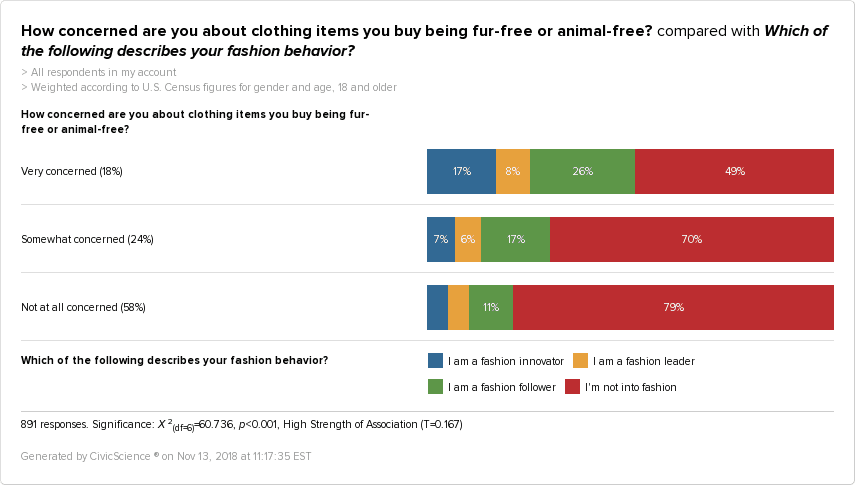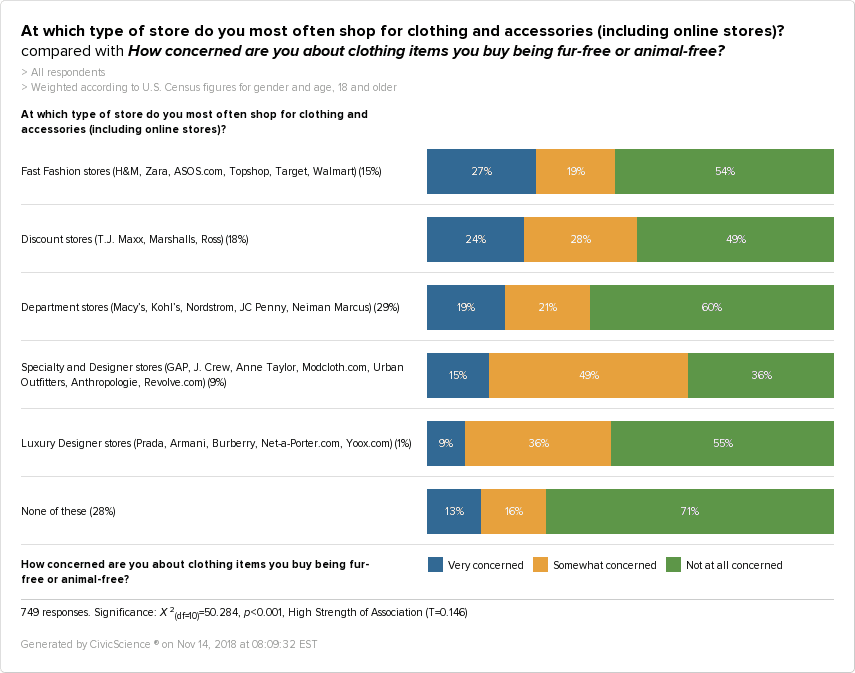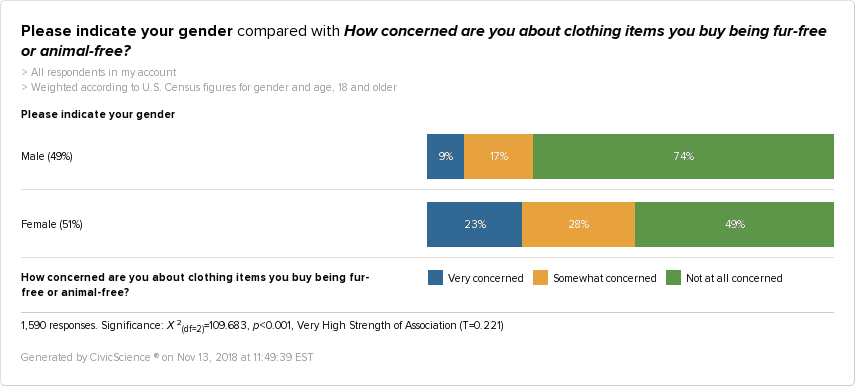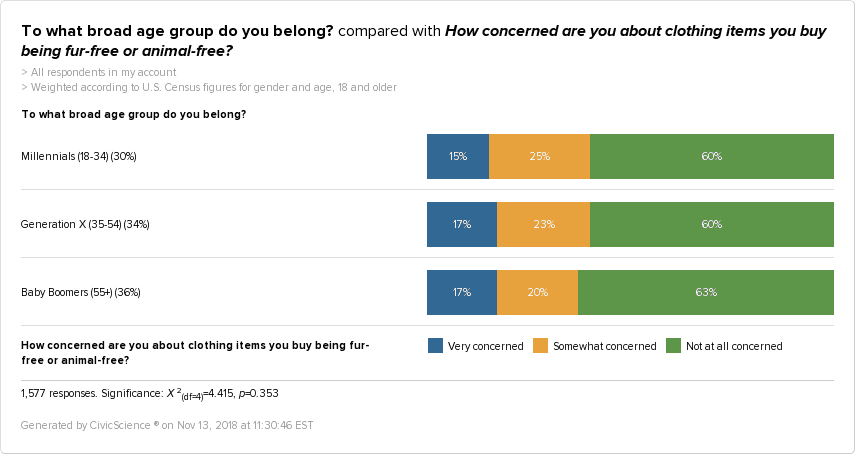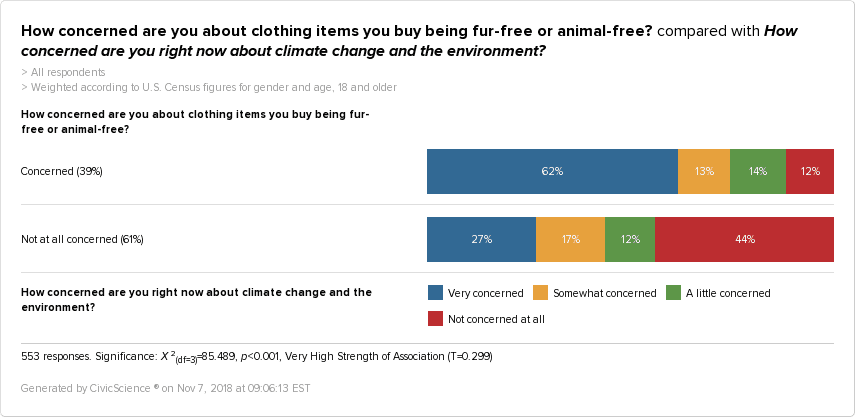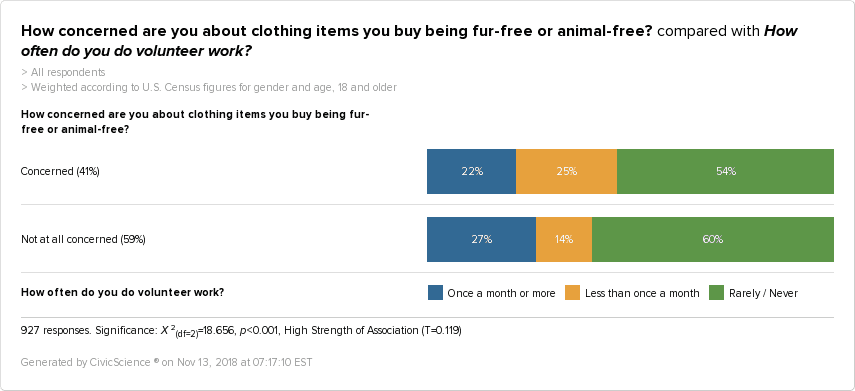For years, in fact, for centuries, fur has dominated the fashion industry. What was first a necessity for warmth slowly evolved into a demonstration of wealth or influence. However, in more recent years, the fashion world has turned a critical eye towards this once-beloved material.
Several high-end fashion brands have begun to denounce fur, publicly committing to going fur-free. While animal rights activists are likely breathing a long-awaited sigh of relief, does the average U.S. adult have feelings about the use of fur in their fashion? CivicScience asked 1,577 U.S. adults if they are concerned about their clothing being fur-free or animal free.
The data revealed that while 61% of respondents do not care about this issue, 16% are very concerned and 23% are somewhat concerned. When taken together, that is 39% of U.S. adults who hold some degree of interest in ensuring that their clothing is fur or animal-free.
Fashion Innovators are Most Concerned
Key to the foundation of this discussion is understanding where respondents fall on the fashion spectrum. People who are most interested in fashion–the innovators and leaders–rank highly in the ‘very concerned’ category. Those who are not into fashion are less concerned about their clothing being fur and animal-free.
While we might like to imagine that all concern is genuine, it is difficult to ignore just how trendy fur-free fashion has become. And, as a result, fashion innovators may also be expressing their concern to keep up with the times. Trend-spotting and trend-setting is, after all, a priority for those deeply invested in the fashion world.
To better understand the fur-free consumer, it is also necessary to know where those most concerned about this issue shop for clothing. As the data reveals, the highest percentage of ‘very concerned’ shoppers opt for fast fashion, while those who are ‘somewhat concerned’ prefer specialty and designer stores.
As the high-end fashion world seems to have realized, 45% of those who shop at luxury designer stores indicate some level of concern regarding fur-free clothing, confirming that the choice to go fur-free is likely very popular amongst this particular demographic. While it is true that 55% of luxury designer shoppers do not care about fur-free clothing, this number is much smaller than other unconcerned groups, such as those who shop at department stores or fast fashion shoppers.
(Gender) Marketing Makes a Difference
From a gender perspective, it quickly becomes evident that fur-free clothing is especially important for women.
However, it should be kept in mind that fashion is, generally speaking, a topic especially marketed towards women. And furs are frequently associated with coats or stoles, pieces typically not worn by men. Perhaps, if the question had specified leather–a material more often linked to menswear–the results would have been different.
Money Matters
When it comes to who has the most concern over fur-free and animal-free clothing, money may play a role. Low-income earners are almost even in both categories, making up the largest percentages of concerned and non-concerned consumers. On one hand, those who are concerned may be showing signs of aspirational shopping. Despite not being able to afford real fur, the idea of owning fur may represent a certain level of success that is desired but currently out of reach.
On the other hand, those low-income earners who are unconcerned could also be influenced by the price. But, in this case, respondents wind up feeling disconnected and less concerned about the use of furs, because of their cost-prohibitive nature.
Middle-income earners are generally more likely to be concerned about the use of animal materials in their clothing, while high-income earners are more likely to not be concerned at all.
This data, while not necessarily surprising, does probe further questions regarding social consciousness, one’s attitude towards purchases, and the impact of one’s dollar on each step of the supply chain.
With these statistics in mind, the potential link between occupation and fur-free concern, or the lack thereof, feels especially resonant. Those in professional and managerial roles, for example, are more likely to be concerned about fur-free clothing. Retirees, on the other hand, are not quite as bothered by the topic. This could be a sign of generational divides. Those in retirement may have grown up in a time when fur was more prevalent than the synthetic fabrics often used now, and may be generally less aware of the current standards and trends in fur-free clothing.
A Fur-Free Stage of Life
As individuals age, their priorities tend to change, along with their responsibilities. When considering opinions on fur-free clothing, concern is greatest amongst respondents under the age of 34. From the age of 35 onwards, those who are very concerned remain consistent, while those somewhat concerned see a gradual decline.
This dip in concern amongst those 55 and up could coincide with individuals in this stage of life seeking to cast aside a certain level of adult responsibility. This is, after all, an age when many are sending, or have sent, children off to college and may have more time for themselves than they’ve had since their thirties; time that can be spent reconsidering one’s priorities.
Parenthood can be an all-consuming activity, with results that show in the data. 18% of those who are very concerned and 31% of those who are somewhat concerned about fur-free clothing are neither parents nor grandparents. This suggests that the respondents in the above graph, whose concern grows and then dips, are more likely to be influenced by a personal evolution of preferences, not linked to child-rearing.
According to this data, having an opinion on the use of animals in clothing may be a luxury reserved for those without parental responsibilities, who have enough time in the day to form a strong opinion on the subject.
Education
Ultimately, in order to have an opinion, one must first be aware that the problem exists. Education is often a factor in awareness. And, as the data explains, concern over fur-free clothing increases with each degree, up until graduate or professional degrees. While 38% of those with a Bachelor’s or Associate’s degree report being concerned, only 20% of those with a graduate or professional degree say the same.
Another statistic to note is that those with a high school diploma or GED are more likely to be concerned about this topic, suggesting that concern over fur-free clothing could be a topic of interest for the younger generation or those just at the start of their higher education journey.
Environmental and Social Consciousness
Although there are many reasons one might dislike the use of animals in their clothing, a major one is environmental consciousness. 62% of those who are concerned over fur-free clothing are also very concerned about climate change, suggesting that these issues could go hand-in-hand.
Concern and action, however, are two different things. And, as the data reveals, lack of concern over animal-free clothing does not necessarily correlate to lack of concern for others. 27% of those who are not concerned about fur-free clothing report volunteering once a month or more. That is an increase from the 22% of monthly volunteers who report having a concern.
While non-concerned respondents are still more likely to never volunteer, we cannot discredit the efforts of those in both categories seeking to make a difference.
Ultimately, individuals will be influenced by a variety of factors when it comes to where they fall in the fur-free conversation. While those deeply invested in the fashion world and those passionate about the environment may be major advocates for brands renouncing the use of fur, there is another swath of the population for whom this discussion is of little interest, primarily because of fur’s high price point. And even then, amongst those who cannot afford fur, owning fur clothing could, in fact, signify an aspirational level of wealth and success.
At the end of the day, each individual’s motivations are so nuanced, we may never fully understand them. However, given the fact that 39% of U.S. adults hold some level of concern over the use of animals in their clothing, the fashion industry is wise to take note and continue moving in a direction that will appeal to an increasingly vocal clientele.

